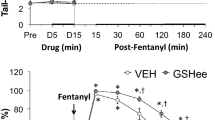Intramuscular administration of the minimum effective doses (MED) of the central analgesics fentanyl and Analgin [translator’s note: metamizole], the NMDA receptor polyamine site agonist spermine, and IEM-1460, an AMPA receptor blocker and agonist of the NMDA receptor polyamine site, induced maximal analgesic effects in the tailflick test in rats. Combined intramuscular administration of Analgin and IEM-1460 and spermine at threshold doses inactive when given alone (1/5 MED) allowed the MED of Analgin to be reduced by a factor of 120 when given in combination with IEM-1460 and by a factor of 10 when given in combination with spermine. Combined intramuscular administration of fentanyl with IEM-1460 and spermine at these threshold doses decreased the MED of fentanyl by a factor of 150 when used with IEM-1460 and a factor of 15 when used with spermine.
Similar content being viewed by others
References
V. E. Gmiro and S. E. Serdyuk, “Bis-ammonium adamantane-containing compounds – novel modulators of the polyamine binding site,” Eksperim. Klin. Farmakol., 63, No. 3, 16–20 (2000).
S. E. Serdyuk and V. E. Gmiro, “Combined blockade of α3β4 H-cholinoreceptors and GluR1 AMPA receptors eliminates clonic-tonic kainate convulsions in rats,” Byull. Eksperim. Biol. Med., 143, No. 5, 548–550 (2007).
S. E. Serdyuk and V. E. Gmiro, “Involvement of gastric afferents in the reflex mechanisms of delayed adaptation to stresses,” Ros. Fiziol. Zh., 81, No. 9, 40–51 (1995).
C. Advokat, A. Ghorpade, and E. Wolf, “Intrathecal excitatory amino acid (EAA) agonists increase tail flick latencies (TFLs) of spinal rats,” Pharm. Biochem. Behav., 48, No. 3, 693–698 (1994).
C. Advokat, J. Prejean, and L. Bertman, “Intrathecal co-administration of morphine and excitatory amino acid agonists produce differential effects on the tail-flick of intact and spinal rats,” Brain Res., 641, No. 1, 135–140 (1994).
R. Kolhekar, S. T. Meller, and G. F. Gebhart, “N-methyl-D-aspartate receptor-mediated changes in thermal nociception: allosteric modulation at glycine and polyamine recognition sites,” Neurosci., 63, No. 4, 925–936 (1994).
K. Lutfy, D. E. Hurlbut, and E. Weber, “Blockade of morphine-induced analgesia and tolerance in mice by MK-801,” Brain Res., 616, No. 1–2, 83–88 (1993).
T. Nishiyama, L. Gyermek, C. Lee, et al., “The systemically administered competitive AMPA receptor antagonist, YM872, has analgesic effects on thermal or formalin-induced pain in rats,” Anaesth. Analg., 89, No. 6, 1534–1537 (1999).
T. Nishiyama, T. L. Yaksh, and E. Weber, “Effects of intrathecal NMDA and non-NMDA antagonists on acute thermal nociception and their interaction with morphine,” Anesthesiology, 89, No. 3, 715–722 (1998).
T. Nishiyama, “Interaction between intrathecal morphine and glutamate receptor antagonists in formalin test,” Eur. J. Pharmacol., 395, No. 3, 203–210 (2000).
C. G. Parsons, “NMDA receptors as targets from drug action in neuropathic pain,” Eur. J. Pharmacol., 429, No. 1–2, 71–78 (2001).
N. Sevostianova, W. Danysz, and A. Y. Bespalova, “Analgesic effects of morphine and loperamide in rat formalin test: interactions with NMDA receptor antagonists,” Eur. J. Pharmacol., 525, No. 1–3, 83–90 (2005).
H. Suh, D. Song, S. Huh, and Y. H. Kim, “Differential potentiative effects of glutamate receptor antagonists in the production of antinociception induced by opioids administered intrathecally in the mouse,” Brain Res. Bull., 52, No. 2, 143–150 (2000).
H. W. Suh, D. K. Song, Y. H. Kim, et al., “Differential antagonism by MK-801 against antinociception induced by opioid receptor agonists administered supraspinally in mice,” Eur. J. Pharmacol., 263, No. 1–2, 217–221 (1994).
M. Yoshikawa, K. Ito, M. Maeda, et al., “Activation of supraspinal NMDA receptors by both S-serine alone or in combination with morphine leads to the potentiation of antinociception in tail-flick test of rats,” Eur. J. Pharmacol., 565, No. 1–3, 89–97 (2007).
Author information
Authors and Affiliations
Corresponding author
Additional information
Translated from Rossiiskii Fiziologicheskii Zhurnal imeni I. M. Sechenova, Vol. 99, No. 12, pp. 1361–1365, December, 2013.
Rights and permissions
About this article
Cite this article
Serdyuk, S.E., Gmiro, V.E. IEM-1460 and Spermine Potentiate the Analgesic Actions of Fentanyl and Analgin in Rats. Neurosci Behav Physi 45, 680–683 (2015). https://doi.org/10.1007/s11055-015-0128-2
Received:
Published:
Issue Date:
DOI: https://doi.org/10.1007/s11055-015-0128-2




